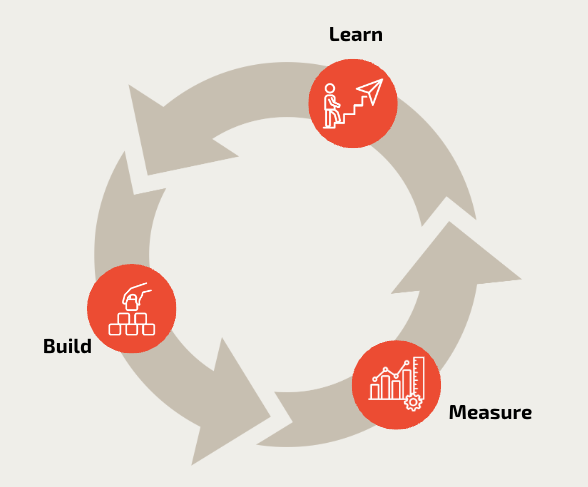Successfully apply build-measure-learn when developing ideas
The lean startup method facilitates the implementation of promising ideas. How the "build-measure-learn" feedback cycle makes it easier for established companies to innovate.

Needs and requirements can change rapidly in markets, so new ideas have to be developed quickly from an idea to a finished product or new service. The lean startup method is popular for enabling innovation teams to react flexibly to changes. With its eponymous "build-measure-learn" feedback cycle, developed by Steve Blank, it offers an ideal approach to overcoming the constant challenges of the business world.
In this blog article, you will learn how to use the method successfully.
The basic principles of the lean startup method
The lean startup method is based on an iterative approach to the development of products or services. Its central principle is to test hypotheses quickly and efficiently in order to find out what customers really want and what they are willing to pay for. By using so-called "minimal viable products" (MVPs) – i.e. simple prototypes or versions of a product – companies can gather feedback at an early stage and adapt their ideas accordingly.
The lean startup method is based on a few basic principles:
- Validated learning: Continuous testing and measuring confirms whether an idea works or not.
- Build-measure-learn: By building a minimum viable product that receives early feedback from customers, adjustments can be made to improve the product.
- Iterative development: The product is developed in small steps and continuously adapted based on customer feedback.
- Experiments: Specific experiments are carried out to test assumptions and gain new insights.
Step-by-step guide with the build-measure-learn approach
The build-measure-learn approach is a central feedback cycle in the lean startup method.

- Build
Create a minimum viable product (MVP) that contains the essential functions of your idea. The MVP serves to demonstrate the basic functionality of your concept and to receive early feedback from potential customers. It should be simple yet effective in order to test market reactions and gain important insights. By focusing on the core functions, you can effectively assess whether your idea will attract interest and what adjustments may need to be made. - Measure
Collect data and measure the performance of the MVP using relevant metrics. This can be, for example, the number of users, the conversion rate, or customer satisfaction. It is important to define the right key figures in order to measure the success of the minimum viable product. The number of users shows the interest in the product, the conversion rate, the effectiveness of customer acquisition and customer satisfaction, and the fulfillment of their needs. - Learn
Analyze the collected data and derive insights from it. Identify strengths, weaknesses, and possible improvements to the MVP. By thoroughly analyzing the data, you can find out which aspects of your minimum viable product are particularly well received by customers and which ones still need to be optimized. It is important to consider both positive and negative feedback in order to make an informed decision about the further development of your concept. By enhancing the strengths, eliminating the weaknesses, and making targeted improvements, you can ensure that your product meets the requirements and expectations of your customers in the best possible way. - Repeat
By continuously repeating the feedback cycle, the MVP is further optimized with each iteration. Each time the build-measure-learn approach is applied, new insights and feedback are incorporated, which are used to continuously improve the product and adapt it to the customer's needs.
Conclusion: the lean startup in established companies
The lean startup method is not only suitable for startups, but can also be successfully applied in established companies. By implementing this method, even larger companies can benefit from an agile and innovative approach. The quick testing of new products as an MVP makes it possible to receive feedback from customers at an early stage and adapt the products specifically to their needs.
However, a certain corporate culture characterized by flexibility, a willingness to experiment, and openness to change is required in order to fully exploit the benefits of the lean startup method. Established companies must be prepared to rethink traditional processes and ways of thinking and embrace the iterative approach of the build-measure-learn cycle.
One area of application in which the method is particularly suitable is intrapreneurship programs. Within such programs, selected employees work over a defined period of time to develop an idea into a convincing concept. By supporting such programs in companies, we train employees in these methods to ensure that they achieve optimal results with the right tools.









